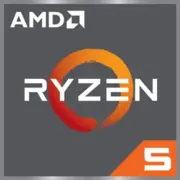AMD Ryzen 5 PRO 4655G

AMD Ryzen 5 PRO 4655G: Review and Practical Guide for Building a PC in 2025
Relevant as of March 2025
Introduction
The AMD Ryzen 5 PRO 4655G processor, released in 2020, remains a popular choice for budget and corporate systems due to its successful combination of performance, energy efficiency, and integrated graphics. Despite the arrival of newer generations like Ryzen 7000 and 8000 series, this APU (Accelerated Processing Unit) continues to attract users who do not require high-end power but value stability and cost-effectiveness. In this article, we will explore whether this processor is still relevant in 2025 and whom it is suitable for.
1. Key Specifications
Zen 2 Architecture and 7nm Process Technology
The Ryzen 5 PRO 4655G is built on the Zen 2 architecture, which is considered outdated in 2025 but still effective for basic tasks. The TSMC 7nm FinFET process technology provides low thermal output (TDP 65W) and good energy efficiency.
- Cores and Threads: 6 cores / 12 threads.
- Frequency: Base — 3.7 GHz, Max — 4.2 GHz.
- Cache: L3 — 8 MB, L2 — 3 MB.
- Graphics: Radeon Graphics (Vega) with 7 CU (448 stream processors) and a frequency of up to 1900 MHz.
Key Features:
- Support for Simultaneous Multi-Threading (SMT).
- Integrated graphics on par with a GTX 1030 (suitable for light gaming and video work).
- PRO security technologies: AMD Shadow Stack, Secure Boot.
2. Compatible Motherboards
AM4 Socket and Chipsets
The processor uses the AM4 socket, limiting the choice of motherboards to models from 2020 to 2023.
Recommended Chipsets:
- B550: Optimal choice (PCIe 4.0 for NVMe, USB 3.2 Gen 2). Example: MSI B550M PRO-VDH WiFi ($120–$150).
- A520: Budget option with no overclocking (suitable for office PCs).
- X570: Overkill for the 4655G but relevant if planning an upgrade to Ryzen 9 5950X.
Notes:
- BIOS update may be required for operation (use motherboards with Flashback feature).
- PRO chipsets (e.g., B550 PRO) support corporate management features.
3. Supported Memory
DDR4 and Limitations
The Ryzen 5 PRO 4655G works only with DDR4:
- Official support: up to 3200 MHz.
- Recommended: 2x8 GB DDR4-3600 (overclocked) for maximum APU performance.
Examples:
- Kingston Fury Renegade DDR4-3600 (CL16) — $75 for a set.
- For budget builds: Crucial Ballistix DDR4-3200 (CL16) — $60.
Important: The integrated graphics uses system memory as video memory. Allocate 2–4 GB in BIOS for gaming.
4. Power Supply Recommendations
Power Consumption and PSU Selection
With a TDP of 65W, the processor consumes up to 88W under load. Considering other components:
- Without a discrete graphics card: A PSU of 400–450W is sufficient (e.g., be quiet! System Power 10, 450W — $55).
- With a graphics card at the NVIDIA GTX 1660 level: A PSU of 550–600W (Corsair CX650M — $80).
Tips:
- Choose power supplies with 80 Plus Bronze certification or higher.
- Avoid cheap noname models — they may operate unstably under peak loads.
5. Pros and Cons of the Processor
Pros:
- Low power consumption and heat generation.
- Integrated graphics suitable for light gaming (CS:GO, Dota 2, GTA V on medium settings).
- Multi-threading support for work tasks (rendering, encoding).
- PRO features for the corporate sector.
Cons:
- Zen 2 architecture lags behind Zen 3/4 in IPC (by 15–20%).
- No support for PCIe 4.0 (only PCIe 3.0).
- Limited upgrade potential: the AM4 platform is being replaced by AM5.
6. Use Cases
Office and Multimedia
- Working with documents, browsers, Zoom.
- Streaming 4K video and services (Netflix, YouTube).
Gaming
- Integrated graphics: 30–60 FPS in Fortnite (1080p, low settings), Overwatch 2 (720p, medium).
- With a discrete graphics card (e.g., RX 6600): 60+ FPS in AAA games (Cyberpunk 2077 on medium settings).
Work Tasks
- Virtualization (VMware, VirtualBox).
- Video editing in DaVinci Resolve (1080p).
7. Comparison with Competitors
Intel Core i5-12400 (Alder Lake)
- Price: $180 (new).
- Pros: Higher performance in single-threaded tasks, DDR5 support.
- Cons: Requires a separate graphics card for gaming.
AMD Ryzen 5 5600G (Zen 3)
- Price: $160 (new).
- Pros: More powerful graphics (Vega 7 vs. Vega 6), IPC 19% higher.
- Cons: No PRO features.
Conclusion: The 4655G only wins with corporate requirements. Otherwise, the 5600G is a better choice.
8. Practical Assembly Tips
1. Motherboard: Choose B550 with HDMI 2.0 for 4K output.
2. Memory: 16 GB DDR4-3200 is the minimum for gaming.
3. Cooling: The stock cooler is sufficient, but for quieter operation — DeepCool GAMMAXX 400 V2 ($25).
4. Storage: NVMe SSD (WD Blue SN580 1TB — $70) for faster boot times.
Example Build:
- CPU: Ryzen 5 PRO 4655G ($170).
- Motherboard: Gigabyte B550M DS3H ($110).
- Memory: 16 GB DDR4-3200 ($60).
- PSU: EVGA 500 BR ($55).
- Total: ~$400 without a graphics card.
9. Final Conclusion: Who is the Ryzen 5 PRO 4655G Suitable For?
This processor is a good choice if:
- You need a budget PC for office, study, or media center.
- Integrated graphics are necessary for light gaming without buying a graphics card.
- Corporate features (remote management, security) are important.
Alternatives:
- For gaming: Ryzen 5 5600G + DDR4-3600.
- For performance: Intel Core i5-13400F + budget graphics card.
In 2025, the Ryzen 5 PRO 4655G remains a niche solution, but its price ($150–170) makes it cost-effective for specific tasks. If you are not chasing the latest technology, this APU is a reliable option.
Basic
CPU Specifications
Memory Specifications
GPU Specifications
Miscellaneous
Benchmarks
Compared to Other CPU
Share in social media
Or Link To Us
<a href="https://cputronic.com/en/cpu/amd-ryzen-5-pro-4655g" target="_blank">AMD Ryzen 5 PRO 4655G</a>